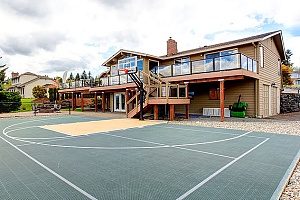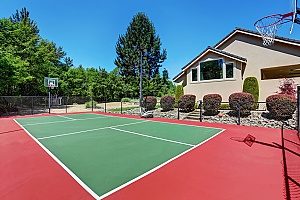 Shooting hoops in the driveway or on the street just is not the same as playing on an actual basketball court. You can easily have the luxury and convenience of a basketball court if you build one in your own backyard. To do this, you’re going to have to decide how big you want your basketball court to be, full-court or half-court. Then you need to decide on what kind of material you’re going to use to build it. While it can be the most costly base option, concrete is the best choice for your home court. Not only will concrete give you the best performance, but it will also give you the longest results out of all your base material options. Another popular option is to use an asphalt pad. These can be cheaper and easier to install, but you need to make sure there’s no chance any large tree roots could grow under the pad and ruin it. If you’re building a half-court, you might want to consider using compacted stone as your base. This is the least expensive option, but it will require periodic maintenance like backfilling and re-compacting over the years.
Shooting hoops in the driveway or on the street just is not the same as playing on an actual basketball court. You can easily have the luxury and convenience of a basketball court if you build one in your own backyard. To do this, you’re going to have to decide how big you want your basketball court to be, full-court or half-court. Then you need to decide on what kind of material you’re going to use to build it. While it can be the most costly base option, concrete is the best choice for your home court. Not only will concrete give you the best performance, but it will also give you the longest results out of all your base material options. Another popular option is to use an asphalt pad. These can be cheaper and easier to install, but you need to make sure there’s no chance any large tree roots could grow under the pad and ruin it. If you’re building a half-court, you might want to consider using compacted stone as your base. This is the least expensive option, but it will require periodic maintenance like backfilling and re-compacting over the years.
Regardless of which base option and court size you decide on, it’s important to build the court on level land with a minimal slope. It’s unlikely that you’re going to find a perfectly leveled rectangle in your backyard, so this means your going to have to put a little work into creating one. This can easily be done with the use of fill dirt.
Fill dirt is used for many construction purposes. It can be used for highway maintenance, filling inground pools, land grading, and foundation purposes (like a foundation for a basketball court or your house). Fill dirt is vastly different from the dirt that is already in your backyard. This is because the dirt in your yard contains what is called organic matter. This organic matter is what helps support the growth of your grass, but is what also makes it unsuitable to level out your land. Organic matter breaks down over time, and as it does the volume of the dirt changes which can result in shifting of the dirt. Shifting dirt under your basketball court could result in serious structural damage to your base material over time. Fill dirt is taken from below the top layer of dirt so that it contains no organic matter. You know this for sure because your Maryland fill dirt contractor will have screened it to ensure no organic matter is present. Fill dirt lacks organic matter, so it can be tightly compacted and you can trust that it’s going to create a strong, lasting foundation for your basketball court to sit on top of for years. For more information about fill dirt and to schedule your Maryland fill dirt delivery, reach out to a Maryland fill dirt contractor.
For more information about fill dirt and to schedule your Maryland fill dirt delivery, reach out to a Maryland fill dirt contractor.
Site Preparation
Start by marking out the parameters of your basketball court in your yard. You’re probably going to want your court to be several inches wider than the actual court lines, so be sure to include this in your measurements. Make sure your basketball court is ideally placed to avoid any potential safety hazards. For example, you need to consider where the basketball poles are going to be placed – you wouldn’t want them too near any electrical wiring. You also wouldn’t want your court near any large trees that someone could accidentally run into, or that could potentially have roots grow under your court and disturb the foundation.
Next begins the process of making sure the ground is level. Nobody wants to play basketball on a bumpy court, so make sure you take your time with this step. This is where fill dirt comes into play. You want to spread it out over the entire area and add additional dirt to any lower points so the entire area is level. If the area you’re building on as a slope, you can add more fill dirt to the low point to help build it up. Next, you want to make sure to compact the dirt. This could be as simple as stomping over the entire area or using tools like a mechanical compactor or hand tamp.
Creating the Base
Once you have your flat foundation of fill dirt, you want to build your base. This step is going to vary depending on which base material you’ve decided to use. If you’re using concrete, you’re going to need to build a wooden frame and layout rebar to support the slab. You can mix the concrete by hand or rent a concrete mixer to make the job a little easier. Remember to leave space for the pole of your hoops. If you’re using asphalt pad or compacted stone, all you have to do is lay the material down over your fill dirt foundation.
Install the Hoops and Paint Lines
Once the concrete is completely dry, you can begin adding the hoops and court lines. Some people like to add another kind of base material like rubber court tiles on top of the concrete to make it softer to play on. These can also make things a lot easier for you if you get some that already have the court lines painted on them.
 If you’re painting your own lines, be sure to use a stencil to ensure that your lines are straight and your measurements are right. Once the paint or tape is placed down, it is not easy to fix or change the lines. When installing your basketball hoops, it is extremely important to make sure they are well installed into the ground. This is necessary for when for someone is hanging on the rim of the hoop after a slam dunk, or for when heavy storm conditions present themselves with severe winds. Having your basketball hoop fall over is the last thing you want. Now that your court is finished and ready to go, all that’s left to do is play your first game!
If you’re painting your own lines, be sure to use a stencil to ensure that your lines are straight and your measurements are right. Once the paint or tape is placed down, it is not easy to fix or change the lines. When installing your basketball hoops, it is extremely important to make sure they are well installed into the ground. This is necessary for when for someone is hanging on the rim of the hoop after a slam dunk, or for when heavy storm conditions present themselves with severe winds. Having your basketball hoop fall over is the last thing you want. Now that your court is finished and ready to go, all that’s left to do is play your first game!









































